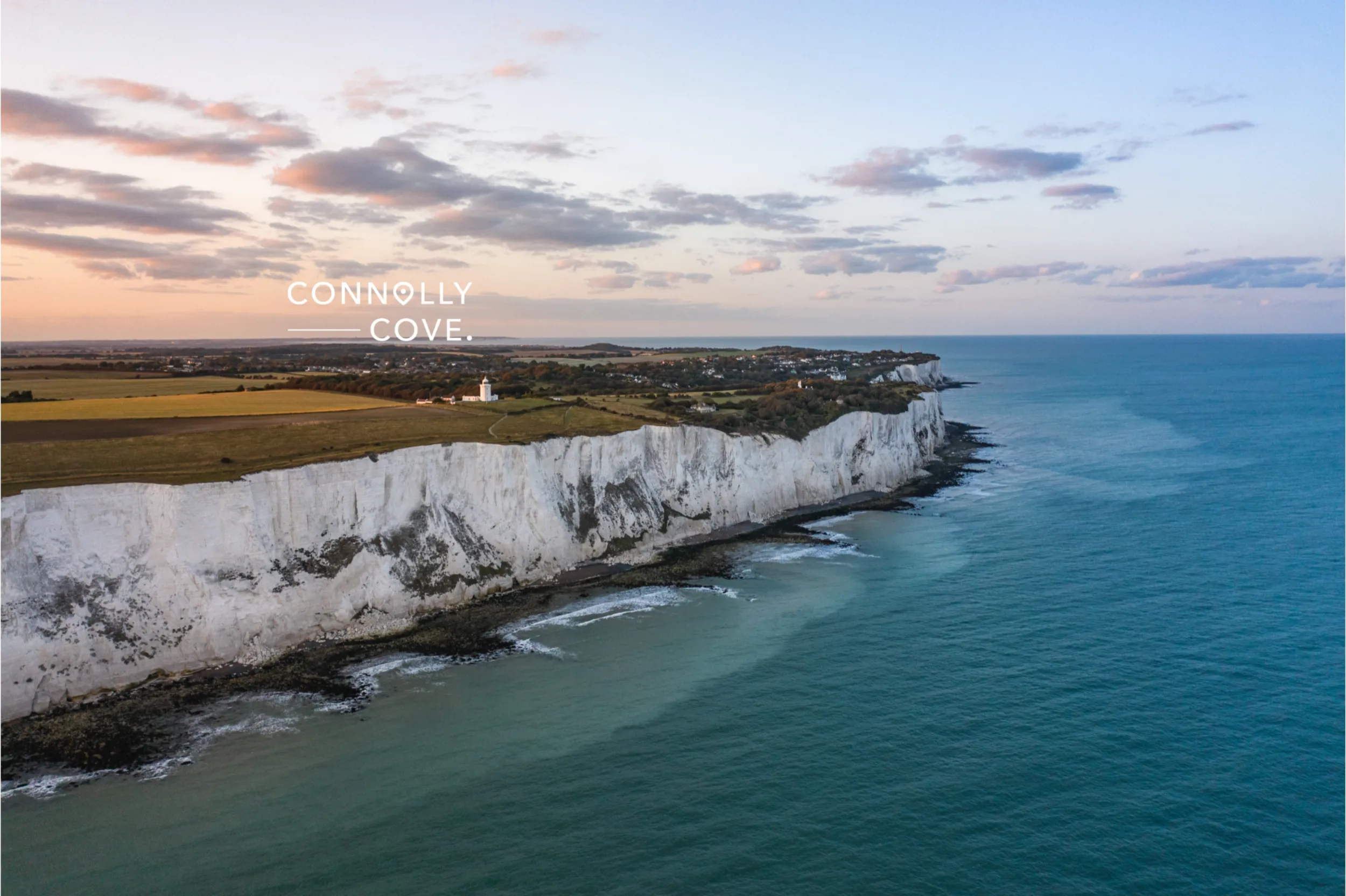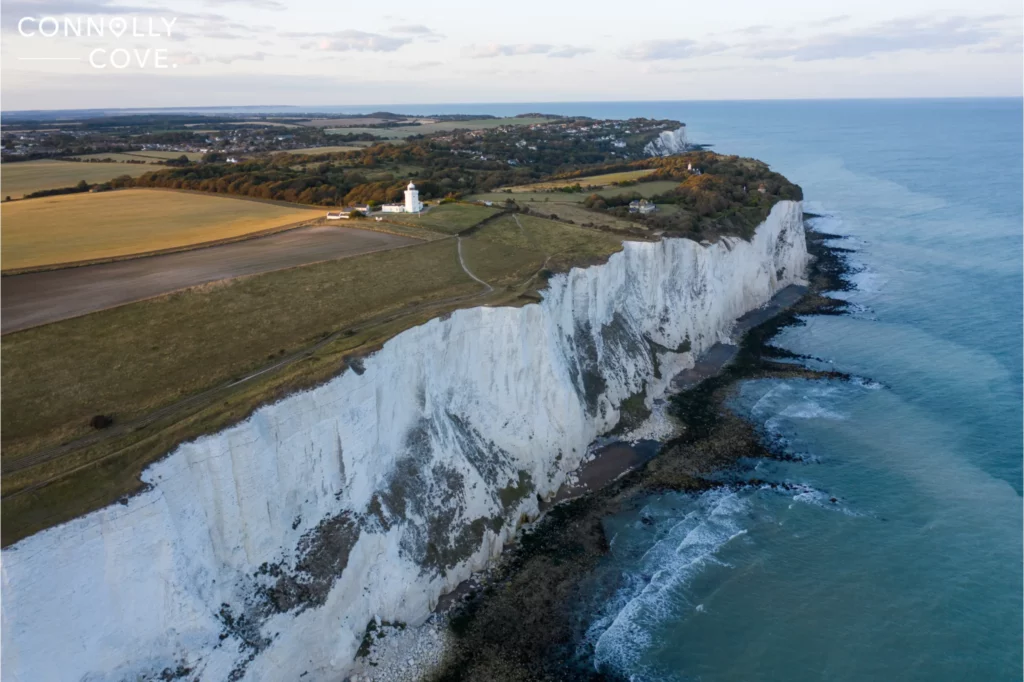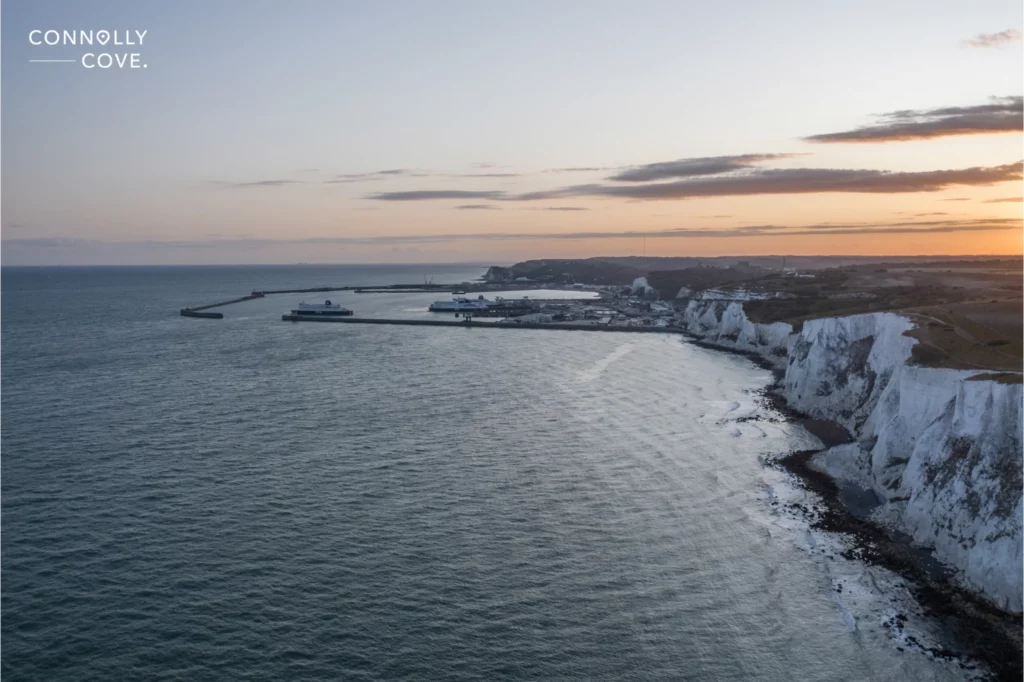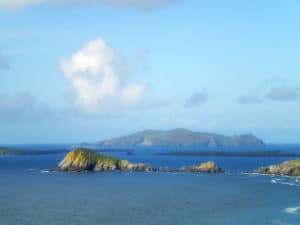White Cliffs of Dover: England’s Unique Wonder

Updated On: November 12, 2023 by Fatma Mohamed
The Cliffs of Dover are one of the most iconic natural landmarks in the UK. Located on the Kent coast, these stunning white cliffs symbolise hope and freedom for many people. They have been featured in countless films, songs, and poems and are a popular tourist destination.
The chalk cliffs, which reach up to 350 feet in height, are an impressive sight to behold. From the top of the cliffs, you can enjoy remarkable views of the English Channel and the French coast on a clear day. The area also has various wildlife, including birds, butterflies, and plants.
Visitors can explore the cliffs on foot, enjoying the fresh sea air and incredible scenery. There are several walking trails to choose from, depending on your level of fitness and how much time you have. For those who want to learn more about the history and geology of the cliffs, there are also guided tours and visitor centres.
Geographical Location
The White Cliffs of Dover are located on the southeast coast of England, overlooking the Strait of Dover, which separates England from France. The cliffs stretch for about 16 km (10 miles) along the coast and reach 110 metres (360 feet) in some places.
The cliffs are part of the North Downs formation, a ridge of chalk hills that runs from Farnham in Surrey to the coast at Dover. The chalk comprises the remains of microscopic marine organisms that lived in the area numerous years ago.
The Strait of Dover is one of the busiest shipping paths in the world, with almost 400 ships passing through it daily. The cliffs are an iconic landmark for sailors and have been used as a navigational aid for centuries. On a clear day, the cliffs are visible from France, about 32 km (20 miles) away. The cliffs also provide astonishing views of the English Channel and the surrounding countryside.
The area around the cliffs is a Site of Special Scientific Interest and a Special Area of Conservation due to its unique geology and the uncommon plant and animal types. Visitors can enjoy various activities, including hiking, bird watching, and exploring the nearby historic town of Dover.
Historical Significance
The White Cliffs of Dover have played a significant role in British history. They have served as a symbol of hope, protection, and freedom for centuries.
Here Are Some of the Historical Events That Have Taken Place at the Cliffs:
- Medieval Times: During the medieval period, the cliffs were used as a lookout point to keep an eye on the English Channel from French invaders.
- World War I: The cliffs were used as a strategic defence point during World War I. The tunnels and bunkers built into the cliffs housed soldiers and ammunition.
- World War II: The cliffs were crucial in World War II. They served as a symbol of British resilience and were featured in many propaganda posters. The tunnels and bunkers were expanded and used as a command centre for the British military.
The White Cliffs of Dover have also been immortalised in literature, art, and music. They are a source of inspiration for many and continue to be an important symbol of British identity.
Geology of the Cliffs

The Cliffs of Dover are a natural wonder located in Kent, England. They are a striking sight, with their white chalk face and streaks of black flint. The cliffs are approximately 350 feet high and stretch over 10 miles along the English Channel.
The geology of the cliffs is fascinating. The chalk that makes up the cliffs was formed almost millions of years ago during the Late Cretaceous period when the ocean submerged the area. The chalk comprises the shells of tiny marine creatures called coccolithophores. These shells accumulated on the ocean floor and were compressed to form the chalk we see today. The cliffs have been eroded over time by the action of the sea, wind, and rain. This erosion has created caves, arches, and stacks along the coastline.
Biodiversity of Cliffs of Dover
The White Cliffs of Dover is not only a national landmark but also an essential place for rare wildlife species, including butterflies, birds, and wildflowers.
The coastal cliffs and slopes, including chalk cliffs and soft cliffs, both have vital, associated foreshore and marine habitats, including nationally and internationally important areas of subtidal and intertidal chalk. The cliffs also provide nesting sites for seabirds such as fulmars, kittiwakes, and guillemots, as well as peregrine falcons and kestrels.
The White Cliffs of Dover also include various rare and endangered plant species, including the Early Spider Orchid, which grows in the chalk grasslands. The clifftops are also home to the Adonis Blue butterfly, a rare and protected species in the UK.
Tourism and Recreation
The White Cliffs of Dover are a famous tourist destination in the UK, drawing visitors from all over the world. With their stunning views and rich history, the cliffs offer a unique and unforgettable experience for anyone who visits.
There are many ways to explore the cliffs and the surrounding area. One of the most popular activities is hiking along the clifftop path, which offers a breathtaking viewpoint of the English Channel and the neighbouring countryside. The path is well-maintained and accessible to people of all ages and abilities, making it an excellent option for families and groups.
For those who prefer a more leisurely experience, there are plenty of other ways to enjoy the cliffs. Travellers can take a boat tour along the coast to see the cliffs from a different perspective or enjoy a picnic on the beach while enjoying the stunning views. In addition to the cliffs, there are many other attractions in the area for visitors to enjoy. The nearby town of Dover offers a range of shops, restaurants, and cultural attractions. At the same time, the surrounding countryside is home to many historic sites and natural wonders.
Cultural References
The White Cliffs of Dover have been a cultural icon for centuries and immortalised in literature, music, and art. Here are some notable references to the cliffs:
- King Lear: In Shakespeare’s play, the climax occurs on the cliffs, and one of the cliffs is named after the Bard himself.
- The White Cliffs of Dover: This song was made famous by Vera Lynn during World War II and became a symbol of hope for peace.
- James Bond: In the James Bond film Moonraker, the villain’s secret hideout is concealed behind the imposing White Cliffs of Dover.
- Harry Potter: In the seventh book, Harry, Ron, and Hermione escape from the Snatchers by jumping off the cliffs and into the sea.
- Doctor Who: In the episode “The Sea Devils”, the Master’s TARDIS is hidden behind the cliffs.
The cliffs have also been featured in various paintings, photographs, and postcards. In addition, the cliffs have been used as a symbol of British identity and resilience, particularly during times of war.
It is worth noting that the White Cliffs of Dover are not the only white cliffs in the world. Other notable examples include the Seven Sisters cliffs in East Sussex, England, and the Cliffs of Moher in Ireland. However, the White Cliffs of Dover remain the most famous and recognisable.
Impact of Climate Change

The White Cliffs of Dover, one of the most iconic natural landmarks in the UK, are at risk due to climate change. According to a study by scientists, the cliffs are at risk of disappearing if action is not taken to protect them.
- In 2023, the White Cliffs of Dover were illuminated in blue and red stripes to represent the change in UK temperatures over the last 100 years as part of a global campaign to raise awareness about climate change.
- Climate change has resulted in increasing sea levels, a significant cliff threat. The cliffs are made of chalk, which is porous and easily eroded by water. The increased prevalence and intensity of storms and extreme weather events generated by climate change can lead to more erosion of the cliffs.
- In addition to the physical effect of climate change on the cliffs, it also affects the plants and animals that live on and around them. The White Cliffs of Dover are home to various rare and endangered species. Climate change can disrupt their habitats and cause them to migrate or become extinct.
- It is essential to take action to protect the White Cliffs of Dover and other natural landmarks from the effects of climate change, including reducing greenhouse gas emissions, promoting sustainable tourism, and implementing measures to protect the cliffs from erosion and rising sea levels.
The White Cliffs of Dover stay as a symbol of natural resilience and beauty, towering over the English Channel with their striking white façade. Beyond their visual splendour, they hold a deep historical significance as guardians of Britain, serving as watchful eyes over the centuries.
The cliffs offer accessible wonders through well-maintained trails and viewing points, with facilities like a panoramic café and ample parking to enhance the visitor experience. The majesty of Dover’s cliffs is a timeless spectacle where nature’s artistry and history’s echoes meet, leaving an unerasable mark on the hearts of those who walk their paths or view them from the sea.






